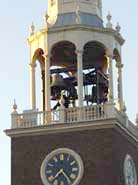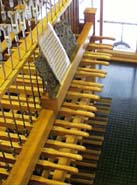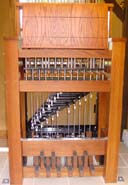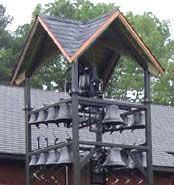

| A chime, as understood in North America, is a set of 8 to 22 stationary bells upon which simple music can be played, such as hymn tunes. Generally, one needs 11 bells to have sufficient variety of possible melodies; around 70% of commonly used hymn tunes may be correctly played on such a set, which will consist of nine diatonic tones in the major key of the largest bell (often termed the tenor), plus two semitones. A 14 note set extends the diatonic range by three more notes, and extends the musical capability to close to 90% of hymn tunes found in most hymnals. Also, 14 notes will permit the playing of quite a variety of suitable classical and folk music as well. Chimes of 18 to 20 notes are very comprehensive, and besides allowing the playing of virtually all hymn and other tunes that may be desired, also allow more use of harmony, and expand the scope of suitable music, to that approaching a small carillon. |
In a church, the tenor bell of a chime is often placed in swinging mountings, for use as a regular church bell for call to worship; in that case, an outside hammer will be used for playing that bell with the others in chime music. A chime may be played from a traditional chimestand, a sturdy wood frame with large levers for each bell, generally aligned in a single row, and grasped and depressed with the hand to play the notes. Each of these levers will be physically connected by a simple cable and pulley arrangement to the clapper of its bell in the tower bell chamber above. |
|
Traditional chimestand |
| Especially when the chime grows to 14 or more bells, it is desirable to play from a small carillon-type keyboard, with or without pedals. Often called a baton keyboard, this has smaller keys with rounded ends which the player strikes or depresses with a loosely-clenched fist; they are arranged in a similar configuration to the keys of a piano, with the semitone (sharp/flat) keys raised and set back, in groups of two and three, similar to the piano’s “black” keys. In a carillon type keyboard, the spatial separation allows the identification of the notes easily by the player’s peripheral vision, so making the keys actually white and black is not necessary. In larger chimes, the inclusion of a few pedals to duplicate the operation of the heaviest several bells, as is done in the carillon, can be a convenience for the player. Where a carillon-type keyboard is used to play a chime, generally a carillon type action will be used, such as a radial action, using individual quadrants, which connect the vertical connecting wires from the keyboard with the bell clapper connections in the bell chamber. Again, this is a completely direct, mechanical link between the player and the bell clapper, providing almost infinite expression controlled directly through the touch on the keys. | |
Baton chime clavier
(carillon type), with player’s bench drawn away to show pedals
|
|
It must be understood that with the accurate tuning we practice in all our bells, it is always possible to start with a small chime and to add bells later on to increase its musical scope. A church or institution may start with, say, an 11-bell chime of small bells, and progress, if space permits, to a large and comprehensive carillon over a period of years. In addition to playing the bells through an expressive manual keyboard, it is possible to play a chime using electrically operated hammers, or from our exclusive electro-pneumatic playing system for chimes and carillons. Either will permit, for instance, remote playing of some or all of the bells from a link to a church’s organ console, or a remotely located piano-type keyboard. |
Also, a computer equipped with the Meeks, Watson & Company proprietary Bell Controls software can be provided, to play the bells on an automatic preset schedule, at any time desired. The ringing of desired church bell functions, and quarter chime and hour strike can be controlled by this equipment as well.
It is important to note, that chimes do not have to be composed of extremely large bells to be very effective musically. Churches or schools with small towers, or even with no tower at all, may have a highly useful and effective instrument of real bells for not a great deal more than many have given to buy complex and soon-obsolete ersatz carillon systems in the past. And these genuine carillon bells will never be obsolete, and can never get “out of tune”. This is but one reason that a chime of real bells is the ideal memorial gift. It is a living memorial that will be not only a valued traditional musical resource of the church, but also a cultural asset to the greater community.



